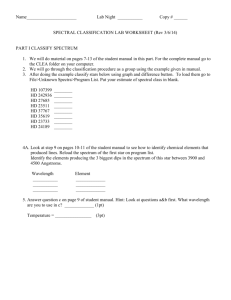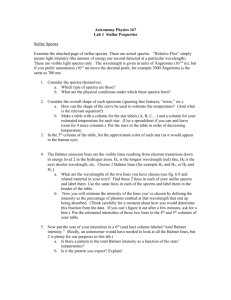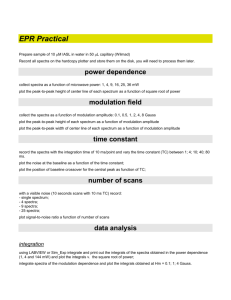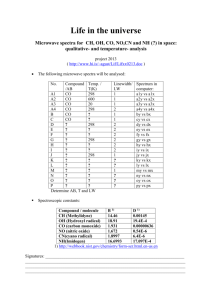OstromMethanePtPRLAuxiliaryMaterial
advertisement
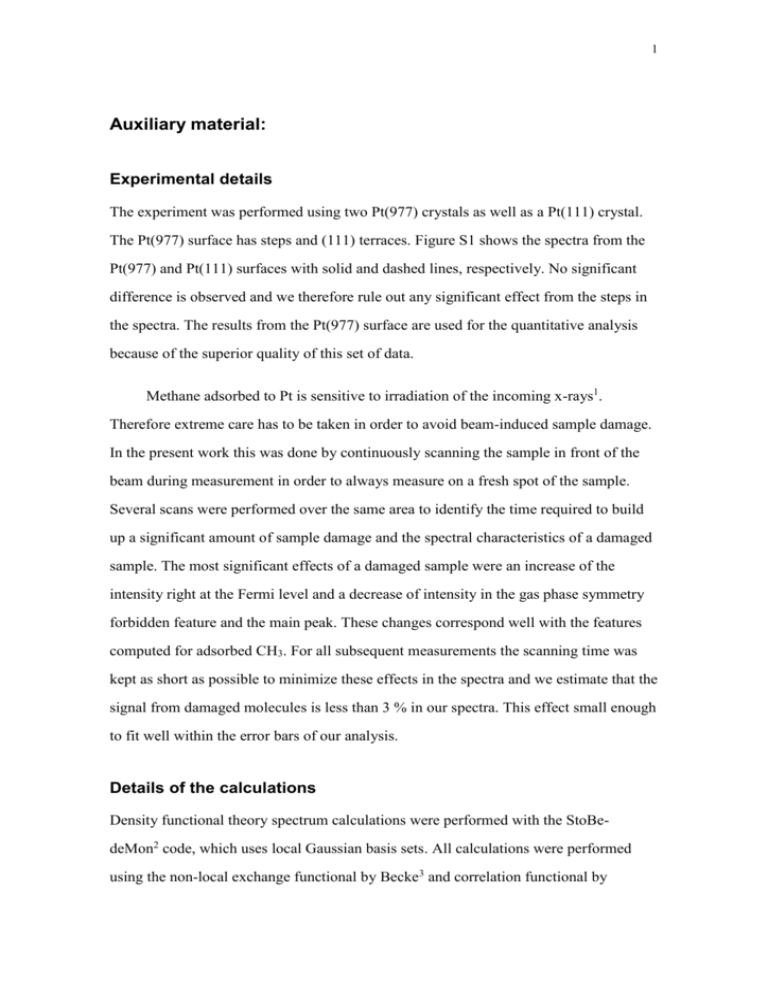
1 Auxiliary material: Experimental details The experiment was performed using two Pt(977) crystals as well as a Pt(111) crystal. The Pt(977) surface has steps and (111) terraces. Figure S1 shows the spectra from the Pt(977) and Pt(111) surfaces with solid and dashed lines, respectively. No significant difference is observed and we therefore rule out any significant effect from the steps in the spectra. The results from the Pt(977) surface are used for the quantitative analysis because of the superior quality of this set of data. Methane adsorbed to Pt is sensitive to irradiation of the incoming x-rays1. Therefore extreme care has to be taken in order to avoid beam-induced sample damage. In the present work this was done by continuously scanning the sample in front of the beam during measurement in order to always measure on a fresh spot of the sample. Several scans were performed over the same area to identify the time required to build up a significant amount of sample damage and the spectral characteristics of a damaged sample. The most significant effects of a damaged sample were an increase of the intensity right at the Fermi level and a decrease of intensity in the gas phase symmetry forbidden feature and the main peak. These changes correspond well with the features computed for adsorbed CH3. For all subsequent measurements the scanning time was kept as short as possible to minimize these effects in the spectra and we estimate that the signal from damaged molecules is less than 3 % in our spectra. This effect small enough to fit well within the error bars of our analysis. Details of the calculations Density functional theory spectrum calculations were performed with the StoBedeMon2 code, which uses local Gaussian basis sets. All calculations were performed using the non-local exchange functional by Becke3 and correlation functional by 2 Perdew4. The central carbon atom, where the core excitation took place, was described with the IGLO-III basis set5, which gives a good representation of the core relaxation; for the other carbon atoms 4-electron ECP:s were used in order to keep the core hole localized6. The hydrogens were described using the (4s) basis of Huzinaga7 in a 3s contraction and one p-function added. The XA spectra were computed using the transition potential approach9, in which the core and valence relaxation are taken into account up to second order by putting half a core hole on the excited atom. This approach allows for calculation of the entire spectrum in a single calculation and the transition energies are then given by the orbital energy difference between the core orbital and unoccupied states. For a better representation of the Rydberg and continuum parts of the XAS spectrum, a large diffuse basis set was added in the last step of the calculation8. This approach has previously been shown to give good results and is described in detail elsewhere9. The spectral intensities are given by the oscillator strengths within the dipole approximation. To form a continuous spectrum from the discrete oscillator strengths the computed spectra were broadened with 0.7 eV Gaussians below the ionization level. The width was increased linearly to 14 eV over a 20 eV interval after this level and was kept constant for higher energies. The transition potential approach tends to overestimate the transition energies by a couple of eV on the absolute energy scale. The spectra were therefore shifted down by 2.3 eV in order to coincide with the absolute experimental energy scale. Determination of the geometry Since present density functional theory does not take dispersion interaction into account, the total energy cannot reliably be used to determine the geometry. Instead the spectral features, which depend on molecular orbital overlaps, were used to determine the geometric structure. 3 Spectra were computed for several different geometries, where the results indicate that the molecules adsorb preferentially with one hydrogen atom pointing towards the surface and that adsorbate-adsorbate interaction has to be taken into account in order to obtain good agreement with the experiment. In addition two spectral parameters were used to fit the distance between the carbon atom and the metal surface (C-Pt) as well as the distance between the carbon atom and the hydrogen atom pointing towards the metal surface (C-Hd). These two parameters were changed independently in a twodimensional space. The spectral features used for the fit were the intensity in the region close to the Fermi level, dominated by adsorption-induced spectral features, and that of the symmetry-forbidden state relative to the main peak as well as the energy splitting between these features. A few spectra computed for different C-Pt and C-Hd distances are shown in Figure 2 of the paper. The transition potential approach, which was used to compute the spectra, assumes the same core and valence relaxation for all states and states of different character may therefore become shifted relative to each other9. In the case of methane this effect was calibrated using the gas phase molecule, where more accurate state-bystate calculations10 of the absorption energies were performed for the first few states. The transition potential calculations gave an energy splitting between the 3a1 and 2t2 resonances of 1.42 eV, which is almost 50 % more than the experimental value of 0.96 eV11. The state-by-state calculations gave a splitting of 1.0 eV, in excellent agreement with the experiment, which allows us to assign this discrepancy to the transition potential; however, due to the large number of low-lying unoccupied metal states from the cluster this correction cannot be computed for the full adsorbed model. However, due to the weak binding to the substrate it is reasonable to assume that the transition potential approach gives the same effect also for the adsorbed molecule. A scaling factor of 2/3 determined from the gas phase was thus used on the computed splitting also for the adsorbate in the determination of the geometry. This scaling factor works in 4 the direction of smaller changes in the geometric structure needed to reproduce the experimental spectral features. The experimental energy splitting for the adsorbate system is 1.3 eV, corresponding to a computed splitting of around 2 eV. It turns out that around the expected adsorbate-surface distance of 4.0-4.5 Å an elongation of the C-Hd bond by 0.017 Å is necessary for every 0.1 Å the molecule is pushed closer to the surface in order to keep the correct splitting of 2 eV for the transition potential spectra. The experimental intensity ratio between the region of adsorption-induced states, close to the Fermi level, and the main feature in the out-of-plane XA spectrum was obtained by subtracting a Lorentzian-shaped step-function accounting for the absorption step background. Subsequently the regions of interest were numerically integrated to obtain the intensities. The corresponding computed intensity ratios between the lower energy region of the XA spectrum and the main peak are shown for some geometries together with the experimental value in Figure S2. In order to easily visualize the problem of geometry determination, only geometries that give a computed energy splitting of 2 eV are shown in the Figure although a larger number of calculations were performed with the C-Hd and C-Pt distances changed independently. The computed relative intensity intersects the experiment at a C-Pt distance of 4.15±0.1 Å and with a C-Hd distance of 1.18±0.05 Å. This geometry is the one that is used for the final calculations in the present letter. It should be noted that using the data measured for methane adsorbed at the Pt(111) surface yields, within the error bars, the same result. Figure S1. Experimental x-ray absorption spectrum of methane adsorbed on Pt(977) and Pt(111), drawn with solid and dashed lines, respectively. The 5 topmost spectrum was recorded with the E-vector of the incoming light out of the surface plane and the bottom spectra with the E-vector in the surface plane. Figure S2. Computed intensity ratios between the adsorption-induced states close to the Fermi level and the main peak in the out-of-plane XA spectra. The “+” signs show the computed intensity ratios for some geometries, that give the correct energy splitting, and the dashed horizontal line shows the experimental intensity ratio. The lines intersect at a C-Pt distance of 4.15 Å and a C-Hd distance of 1.18 Å. 1 2 3 4 5 6 7 8 9 10 11 R. Larciprete, A. Goldoni, A. Groso, et al., Surface Science 482-485, 134 (2001). StoBe-deMon version 1.0, K. Hermann and L.G.M. Pettersson, M.E. Casida, C. Daul, A. Goursot, A. Koester, E. Proynov, A. St-Amant, and D.R. Salahub. Contributing authors: V. Carravetta, H. Duarte, N. Godbout, J. Guan, C. Jamorski, M. Leboeuf, V. Malkin, O. Malkina, M. Nyberg, L. Pedocchi, F. Sim, L. Triguero, and A. Vela, StoBe Software, 2002. A. D. Becke, Phys. Rev. A 38, 3098 (1988). J. P. Perdew, Physical Review B 33, 1033 (1986). W. Kutzelnigg, U. Fleischer, and M. Schindler, NMR-Basic Principles and Progress (Springer-Verlag, Heidelberg, 1990). L. G. M. Pettersson, U. Wahlgren, and O. Gropen, J. Chem. Phys. 86, 2176 (1987). S. Huzinaga, Journal of Chemical Physics 42, 1293 (1965). H. Ågren, V. Carravetta, O. Vahtras, et al., Chemical Physics Letters 222, 75 (1994). L. Triguero, L. G. M. Pettersson, and H. Ågren, Physical Review B 58, 8097 (1998). C. Kolczewski, R. Püttner, O. Plashkevych, et al., Journal of Chemical Physics 115, 6426 (2001). J. Schirmer, A. B. Trofimov, K. J. Randall, et al., Physical Review A 47, 1136 (1993).

